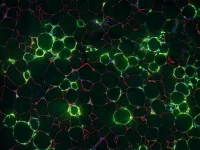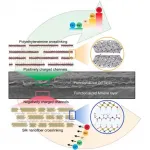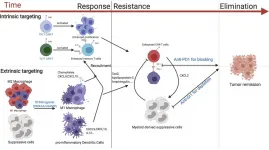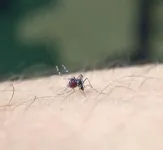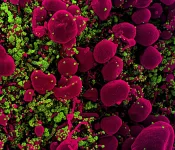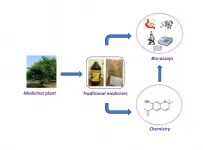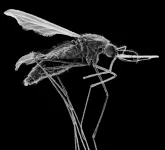(Press-News.org) DALLAS - Dec. 30, 2020 - When fat cells in the body are stuffed with excess fat, the surrounding tissue becomes inflamed. That chronic, low-level inflammation is one of the driving factors behind many of the diseases associated with obesity. Now, UT Southwestern scientists have discovered a type of cell responsible, at least in mice, for triggering this inflammation in fat tissue. Their findings, published in Nature Metabolism, could eventually lead to new ways to treat obesity.
"The inflammation of fat cells in obese individuals is linked to many of the comorbidities we associate with being overweight - cancer, diabetes, heart disease, and infection," says study leader Rana Gupta, Ph.D., associate professor of internal medicine. "By identifying these cells, we've taken a step toward understanding some of the initial events that contribute to that inflammation."
When a person consumes more calories than needed, the excess calories are stored in the form of triglycerides inside fat tissue, also known as white adipose tissue (WAT). Researchers know that in obese people, WAT becomes overworked, fat cells begin to die, and immune cells become activated. But the exact mechanism by which this inflammation occurs isn't fully understood.
While many studies have focused on the signaling molecules produced by the fat cells or immune cells in WAT that might contribute to inflammation, Gupta's team took a different approach. They focused instead on the vessels that carry blood - as well as immune cells and inflammatory molecules - into WAT.
In 2018, Gupta and his colleagues identified a new type of cell lining these blood vessels in mice - an adipose progenitor cell (APC), or precursor cell that goes on to generate mature fat cells. But unlike most APCs, the new cells - dubbed fibro-inflammatory progenitors, or FIPs - produced signals that encouraged inflammation. In the new work, the researchers looked more closely at the role of the FIPs in mediating inflammation.
Within just one day of switching young male mice to a high-fat diet, Gupta and his colleagues discovered that the FIPs quickly increased the number of inflammatory molecules produced. After 28 days on a high-fat diet, they found a substantial increase in the proportion of FIPs compared with other APCs.
"This is the first study to demonstrate that these cells play a very active, early role in being gatekeepers of inflammation in fat tissue," says Gupta.
To show that the increase in the number and activity of the FIPs was not just a side effect of already-inflamed fat cells, the team removed a key immune signaling gene, Tlr4, from the FIPs in some mice. After five months on a high-fat diet, the mice lacking Tlr4 had gained just as much weight, and just as much fat, as other mice on a high-fat diet. But the genetically engineered mice - with FIPs that could no longer generate the same signals - no longer had high levels of inflammation. Instead, the levels of inflammatory molecules in their WAT were closer to the levels seen in mice on low-fat diets.
Gupta and his colleagues went on to show that increasing levels of a related signaling molecule, ZFP423, in FIPs can also ameliorate the inflammation in mouse fat cells. The findings point toward possible avenues to pursue to lower the risk of disease in people with obesity.
"It looks like ZFP423 could be an important brake in terms of slowing the inflammatory signals in these cells," says Gupta. "Of course, it remains to be seen if that's true in humans as well as mice."
Gupta's group is planning future experiments to better understand what aspect of a high-fat diet initiates the increased inflammatory signaling in FIPs, as well as whether the results hold true in human fat.
INFORMATION:
Other UTSW researchers who contributed to this study were Bo Shan, Mengle Shao, Qianbin Zhang, Chelsea Hepler, Vivian Paschoal, Spencer Barnes, Lavanya Vishvanath, Yu An, Lin Jia, Venkat Malladi, Douglas Strand, Olga Gupta, Joel Elmquist and Dayoung Oh.
This research was supported by funds from the National Institutes of Health (NIDDK F31DK113696, R01 DK104789, R56 DK119163, R01 DK119163, R01 DK115477, R01 DK108773, R03 DK101865, PO1 DK088761 and NIAAA K01AA024809), the American Heart Association (16POST26420136 and 14SDG19880020), the American Diabetes Association (1-18-PMF-030) and the Cancer Prevention and Research Institute of Texas (RP150596).
About UT Southwestern Medical Center
UT Southwestern, one of the premier academic medical centers in the nation, integrates pioneering biomedical research with exceptional clinical care and education. The institution's faculty has received six Nobel Prizes, and includes 23 members of the National Academy of Sciences, 17 members of the National Academy of Medicine, and 13 Howard Hughes Medical Institute Investigators. The full-time faculty of more than 2,500 is responsible for groundbreaking medical advances and is committed to translating science-driven research quickly to new clinical treatments. UT Southwestern physicians provide care in about 80 specialties to more than 105,000 hospitalized patients, nearly 370,000 emergency room cases, and oversee approximately 3 million outpatient visits a year.
Lithium is an energy-critical element that is considered to be a geopolitically significant resource. However, the supply of lithium may not be enough to meet continuously increasing demand. As a result, scientists are looking for new ways to extract lithium ions.
Ion selective membranes have already been used extensively for water treatment and ion sieving in electrodialysis technology. However, conventional membranes exhibit low and useless Li+ selectivity, making them insufficient for meeting industry requirements.
Chinese scientists have recently made progress in the preparation and application of a bioinspired ...
Arctic sea ice has been rapidly declining in recent decades, and changes in arctic sea ice can have a significant impact on global weather and climate through interactions with the atmosphere and oceans. In addition, the Arctic shipping routes are a shortcut to connect the major countries in the Northern Hemisphere. The Arctic region is also rich in natural resources and biological resources. Simulation of the Arctic sea ice could provide valuable information for Arctic shipping as well as climate studies, and it is therefore urgent to evaluate the ability to simulate Arctic sea ice and diagnose the sources of simulation errors.
To address the issue of error source identification, ...
Experts in optical physics have developed a new way to see inside living cells in greater detail using existing microscopy technology and without needing to add stains or fluorescent dyes.
Since individual cells are almost translucent, microscope cameras must detect extremely subtle differences in the light passing through parts of the cell. Those differences are known as the phase of the light. Camera image sensors are limited by what amount of light phase difference they can detect, referred to as dynamic range.
"To see greater detail using the same image sensor, we must expand the dynamic range so that we can ...
Activating an immune signaling pathway best known for fighting viral and bacterial infections can boost the ability of genetically engineered T cells to eradicate breast cancer in mice, according to a new study by researchers at the University of North Carolina. The study, to be published December 31 in the Journal of Experimental Medicine (JEM), suggests that CAR T cells, which are already used to treat certain blood cancers in humans, may also be successful against solid tumors if combined with other immunotherapeutic approaches.
Chimeric antigen receptor (CAR) T cells are a type of white blood cell that have been genetically engineered to recognize ...
The Asian tiger mosquito does not pose a major risk for Zika virus epidemics, according to a study published December 31 in the open-access journal PLOS Pathogens by Albin Fontaine of the Institut de Recherche Biomédicale des Armées, and colleagues.
Zika virus has triggered large outbreaks in human populations, in some cases causing congenital deformities, fetal loss, or neurological problems in adults. While the yellow fever mosquito Aedes aegypti is considered the primary vector of Zika ...
A novel computational drug screening strategy combined with lab experiments suggest that pralatrexate, a chemotherapy medication originally developed to treat lymphoma, could potentially be repurposed to treat Covid-19. Haiping Zhang of the Shenzhen Institutes of Advanced Technology in Shenzhen, China, and colleagues present these findings in the open-access journal PLOS Computational Biology.
With the Covid-19 pandemic causing illness and death worldwide, better treatments are urgently needed. One shortcut could be to repurpose existing drugs that were originally developed to ...
Multiple bouts of blood feeding by mosquitoes shorten the incubation period for malaria parasites and increase malaria transmission potential, according to a study published December 31 in the open-access journal PLOS Pathogens by Lauren Childs of Virginia Tech, Flaminia Catteruccia of the Harvard T.H. Chan School of Public Health, and colleagues. Given that mosquitoes feed on blood multiple times in natural settings, the results suggest that malaria elimination may be substantially more challenging than suggested by previous experiments, which typically involve a single blood meal.
Malaria ...
The discovery of new drugs is vital to achieving the eradication of neglected tropical diseases (NTDs) in Africa and around the world. Now, researchers reporting in PLOS Neglected Tropical Diseases have identified traditional Ghanaian medicines which work in the lab against schistosomiasis, onchocerciasis and lymphatic filariasis, three diseases endemic to Ghana.
The major intervention for NTDs in Ghana is currently mass drug administration of a few repeatedly recycled drugs, which can lead to reduced efficacy and the emergence of drug resistance. Chronic infections of schistosomiasis, onchocerciasis and lymphatic filariasis ...
In the ongoing arms race between humans and the parasite that causes malaria, Taane Clark and colleagues at the London School of Hygiene and Tropical Medicine (LSHTM) report that new mutations that enhance resistance to a drug used to prevent malaria in pregnant women and children are already common in countries fighting the disease. The new results are published December 31 in PLOS Genetics.
Malaria causes about 435,000 deaths each year, primarily in young children in sub-Saharan Africa. Despite a long-term global response, efforts to control the disease are hampered by the rise of drug-resistant strains of the parasite species that cause malaria. Sulfadoxine-pyrimethamine (SP), ...
UNIVERSITY PARK, Pa. -- A desalination membrane acts as a filter for salty water: push the water through the membrane, get clean water suitable for agriculture, energy production and even drinking. The process seems simple enough, but it contains complex intricacies that have baffled scientists for decades -- until now.
Researchers from Penn State, The University of Texas at Austin, Iowa State University, Dow Chemical Company and DuPont Water Solutions published a key finding in understanding how membranes actually filter minerals from water, online today (Dec. 31) in Science. The article will be featured on the print edition's cover, to be issued tomorrow (Jan. ...
